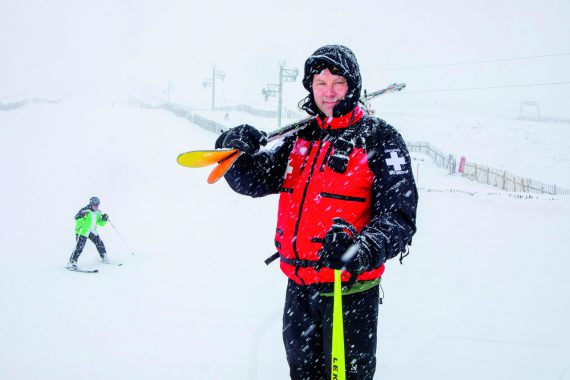Working life: Practising on the piste

8.30am (ish)
I look out of the window and see that it’s a good day to ski, so I set off on the 20-minute drive to Glenshee Ski Centre. Seeing the granite boundary stone as I cross into the Cairngorms National Park feels like freedom. The scenery, with its mountains and lochs, is stunning. Occasionally, if I’ve decided to start early, I’m lucky enough to see a pink sunrise, meaning it’s a blue sky day with lots of snow on the ground.
I have always had a love of the great outdoors, a passion encouraged by the Scottish Youth Hostels Association and then Edinburgh’s Hillend ski centre, where my primary school took us for a week to learn to ski. One of my earliest memories is from when I was seven, at Glenshee, with ski boots on the wrong feet, trying to learn the snowplough in the sleet and ending up in a burn.
I credit the Scottish Highlands and skiing for giving me the resilience to pursue a career in medicine, although I started out as a yachtsman. Now, working as a locum GP, general practice allows me the flexibility to spend time skiing.
10.00am (ish) to 11.00am
I get my ski gear on. It has to be suitable for arctic conditions – even if it’s a nice sunny day in the valley, it could be boilerplate ice (hard blue snow ice) at the top, with winds that feel as if you are being sand-blasted.
I check in with the head patroller and take a radio so I can alert the ski patrol if I see anyone in trouble. I’m a volunteer but ski patrolling is a paid role. The patrol team’s duties include marking the boundaries of the ski area with poles and nets to ensure skiiers don’t wander off into the wilderness, dealing with incidents and managing casualties. We have paramedics, a retired plastic surgeon and a polar expedition leader.
I’m not assigned to a particular area. Keen to explore, I spend some time covering the ground, on the look-out for casualties, dropping in on the resident patrollers to see if I can be of any help. The slopes are busy on Saturday and Sunday with a couple of thousand people, but during the week there’s also fairly steady traffic.
11.30am
I’m called to a young child who is having a suspected asthma attack at the bottom of the ski lift. I sprint over – in ski boots – to assess her, then radio for a Ski-Doo to bring her to the first-aid station.
Ski patrollers are generally excellent at managing head, back and limb trauma but they have less experience with exacerbations of long-term medical conditions. This is probably where my GP contribution is most valuable – I can be radioed from anywhere on site to review a casualty at the first-aid bay.
2.00pm
I get a call to attend a man on the Tiger – a steep, black run – with a suspected broken leg. I assess him, then we load him onto a sledge, wrapped warmly in a casualty bag with his limb splinted.
One patroller skis in front of the sledge, controlling the descent with two handles; a second can apply a braking force from behind with a rope. Getting down a steep slope is quite a challenge.
Casualty handling on a sledge evacuation has been a major learning experience. The sense of satisfaction in a high mountain rescue is very rewarding. Since I began patrolling, I have taken the BASICS and Royal College of Surgeons emergency and trauma care certificates, but any GP who skis can offer valuable support. Ski patrol is a worldwide occupation and conferences, training and experience are available in far-flung, exotic locations.
4.00pm
I’m called to the top of the Glas Maol black run in freezing white-out conditions to help look for a young beginner. Her boyfriend took her up there and her family report they should have been back over an hour ago. The two are found, and we shepherd them slowly down the steep run. Our patroller debriefs them at the bottom.
Assisting ski patrol help keep me interested in medicine. Once you are experienced, you need a new challenge – this is skiing with a purpose, being part of a team helping kids safely develop a love for wild Scottish places – and stay out of the burns.
Profile – Dr Ken Murray
Roles
Out-of-hours GP in Royal Deeside and Tayside; volunteer medic with Glenshee Ski Centre, Aberdeenshire
Qualifications
BASICS pre-hospital emergency care and Royal College of Surgeons advanced trauma life support, BASP ski patrol training
Hours per week
Four or five out-of-hours shifts; half a day on ski patrol in snow season
Pulse July survey
Take our July 2025 survey to potentially win £1.000 worth of tokens












